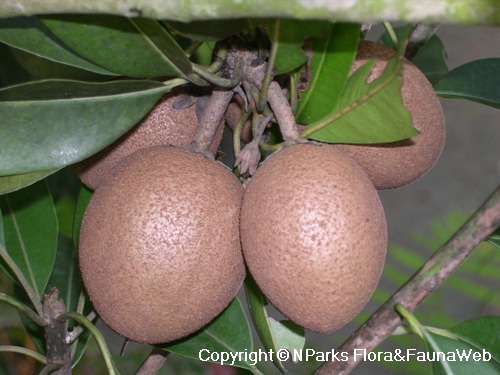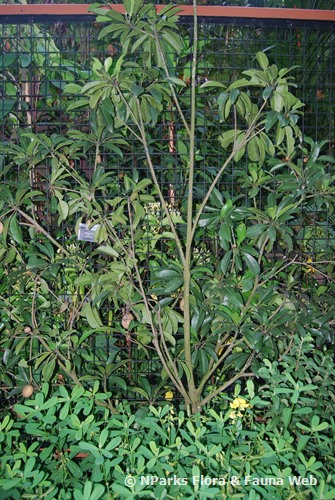.jpg)
Back
Manilkara zapota
| Family Name: | Sapotaceae |
| Synonyms: | Sapota zapotilla, Achras zapota |
| Common Name: | Chiku, Sapodilla, Sauh Menila, Naseberry, Nispero, Chicle, Chicle Gum, Ciku, 人心果 |
Name
Classifications and Characteristics
| Plant Division | Angiosperms (Flowering Seed Plants) (Dicotyledon) |
|---|---|
| Plant Growth Form | Tree (Big (>30m)) |
| Lifespan (in Singapore) | Perennial |
| Mode of Nutrition | Autotrophic |
| Plant Shape | Tiered |
| Maximum Height | 18 m |
Biogeography
| Native Distribution | Tropical Americas |
|---|---|
| Native Habitat | Terrestrial (Primary Rainforest) |
| Preferred Climate Zone | Tropical |
Description and Ethnobotany
| Growth Form | Tree up to 18-30 m tall. |
|---|---|
| Foliage | Glossy leaves are elliptic (7.5-11.3 cm long). They are spirally arranged near the branch tips. |
| Flowers | Pale green flowers are bell-shaped and have 6 stamens (male, pollen-producing part). |
| Fruit | Fruits are round, oval or ellipsoidal. They contain 3-12 hooked seeds. |
| Ethnobotanical Uses | Edible Plant Parts : Edible Fruits Food (Fruit or Vegetable): The fruit is eaten raw or used in desserts. Others: Young fruits. high tannin content, boiled and decotion drunk to treat diarhhea; Seed paste applied to bite and sting wounds due to poisionous animals; Young leaf shoots washed to remove sap and eaten raw or with rice in Indonesia. Gummy latex used in tropics to fill dental cavities or make figurines; Wood strong and durable, used to make beams and furniture; Gummy latex (chicle) tapped from trunk during rainy season (latex flows better) for making chewing gum and adhesives; |
Landscaping Features
| Desirable Plant Features | Ornamental Fruits |
|---|---|
| Landscape Uses | General, Container Planting, Coastal |
| Thematic Landscaping | Economic Garden |
| Usage Hazard - Cons | Irritant - Sap, Toxic Upon Ingestion |
| Usage Hazard - Cons Remarks | Sticky sap in immature fruits, broken surfaces of plant; Seed kernel contains saponin and sapotinin -- injestion of more than 6 seeds will cause vomitting and abdominal pain. |
Fauna, Pollination and Dispersal
| Pollination Method(s) | Biotic (Fauna) (Insects (Bee)) |
|---|
Plant Care and Propagation
| Light Preference | Full Sun |
|---|---|
| Water Preference | Moderate Water |
| Plant Growth Rate | Moderate |
| Rootzone Tolerance | Saline Soils / Salt Spray, Drought Tolerant, Fertile Loamy Soils, Well-Drained Soils, Alkaline high pH Soils |
| Diseases | Fruits may need to be covered with net to protect them from fruit bats. Fruits could be attacked by fruit flies, banana-spotting bugs and Phytopthora palmivora fungus. Leaves may be affected by rusts, bacterial rot (Septoria sp.) and Rhyparida beetles. |
| Pest(s) | Associated with, Sucking Insects, Chewing Insects |
| Propagation Method | Seed, Grafting, Marcotting, Air-Layering |
| Propagule Establishment Remarks | Seeds, viable for years if stored dry, germinate easily, but growth is slow. Seed-grown plants take 5-8 years to bear fruit, variable in quality and form. Air-layered plants take 2 year to fruit; Side-grafting of year-old seedlings onto rootstocks also commercially practised. |
| Maintenance Requirements Remarks | Soil must be well-drained, or else tree bears fruits poorly. In India, trees may be watered with brackish or saline water to improve fruit yield. |
| Planting Distance | 1 |
Foliar
| Foliage Retention | Evergreen |
|---|---|
| Mature Foliage Colour(s) | Green |
| Mature Foliage Texture(s) | Glossy / Shiny, Leathery, Thick |
| Foliar Type | Simple / Unifoliate |
| Foliar Arrangement Along Stem | Spiral |
| Foliar Shape(s) | Non-Palm Foliage (Elliptical) |
| Foliar Venation | Pinnate / Net |
| Foliar Margin | Entire |
| Foliar Apex - Tip | Acute |
| Foliar Base | Acute |
| Typical Foliar Area | Microphyll ( 2.25cm2 - 20.25 cm2 ) |
| Leaf Area Index (LAI) for Green Plot Ratio | 4.0 (Tree - Dense Canopy) |
Non - Foliar and Storage
| Trunk Type (Non Palm) | Woody |
|---|---|
| Bark Colour(s) | Dark brown |
| Mature Bark Texture | Fissured, Plated |
| Stem Type & Modification | Woody |
| Root Type | Underground (Tap Root, Fibrous Root) |
Floral (Angiosperm)
| Flower & Plant Sexuality | Bisexual Flowers |
| Flower Colour(s) | Green |
|---|---|
| Flower Symmetry | Radial |
| Flower Size - Remarks | Small, inconspicuous, solitary, at leaf axils |
| Flowering Period | Free-Flowering |
| Flowering Opening Time | Time-Independent |
| Flowering Habit | Polycarpic |
Fruit, Seed and Spore
| Mature Fruit Colour(s) | Brown |
|---|---|
| Fruit Classification | Simple Fruit |
| Fruit Type | Fleshy Fruit , Berry |
Image Repository
Others
| Master ID | 1721 |
|---|---|
| Species ID | 3014 |
| Flora Disclaimer | The information in this website has been compiled from reliable sources, such as reference works on medicinal plants. It is not a substitute for medical advice or treatment and NParks does not purport to provide any medical advice. Readers should always consult his/her physician before using or consuming a plant for medicinal purposes. |

.jpg)












